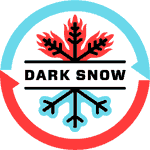Dark matter for Greenland melting
Posted on 7 January 2013 by Jason Box
 We're now launching the first-of-a-kind Arctic expedition relying totally on internet crowd funding.
We're now launching the first-of-a-kind Arctic expedition relying totally on internet crowd funding.
A video overview of our mission, the Dark Snow Project appears 7 Jan here. The youtube video is here.
The Dark Snow narrative
In waiting area of New York’s Laguardia airport last June, an hour before leaving on month long Greenland expedition, my 23rd, I beheld crowds captivated by TV news of unprecedented Colorado wildfires.
Since I had been researching changes in the albedo, or reflectivity, of the Greenland ice sheet, I was reminded that wildfire, increasing with climate change [1, 2, 3], would be depositing more light-absorbing black carbon [soot] on the cryosphere [snow and ice], multiplying the existing heat-driven ice-reflectivity [albedo] feedback.

A tundrafire rages in northern Alaska in 2011.
While my recently published work had linked Greenland’s reflectivity decline with climate warming through a heat-driven melt process (heat drives ice crystal rounding that reduces its reflectivity), what remained unresolved was the relative importance changing soot concentrations. Soot contains black carbon that acts as a multiplier in the existing heat-driven feedback process.
From Laguardia, I rang fellow Colorado native and NASA JPL snow optics expert Dr. Tom Painter to ask if snow samples delivered to his laboratory could be used to identify wildfire soot? His answer, “Yes.”
I said, “Tom, with snow samples, is it possible to discriminate wildfire soot with that from industrial sources?” ... “Yes”. Before the flight boarded we had resolved the goal of sampling Greenland’s ice and snow for soot and other light absorbing impurities. We only had to somehow muster resources to get up to the ice sheet’s highest elevations where the satellite data showed a conspicuous pre-melt reflectivity decline...

7.5% reflectivity decline in July for the upper elevations ice sheet, corresponding with 50 exajoules more solar energy absorption by the ice sheet for this month between 2000 and 2012. For the June-August [summer] period, the ice sheet is now absorbing and additional 1.5 times the total US annual energy consumption[1]. Part of the reflectivity decline is due to the effect of heat, rounding ice crystals, reducing light scattering. Another component of the decline is soot. But we don't know if the effective importance of soot is 1%, 10%, 50%?
We thus began a first-of-a-kind crowdfunding experiment: can we raise funds to return to Greenland to sample its snow to measure the radiative impact of the 2012 fire season?
Because we can't precisely measure fire's increasing role in cryospheric change unless we reach our funding goal, please consider:
- giving in one of the following ways:
- via PayPal at http://darksnowproject.org/ a US tax deductible donation;
- a (US tax deductible) check mailed to Earth Insight Foundation Inc., PO Box 699, San Jose, CA 95106
- mailing a check to Dark Snow attn. Michele Cook, Byrd Polar Research Center, Scott Hall Rm. 108, 1090 Carmack Rd., Columbus, OH, 43210.
- distributing this message in a call for support to those you expect would support Dark Snow Project































 Arguments
Arguments
























 0
0  0
0






Comments